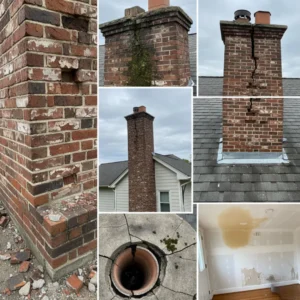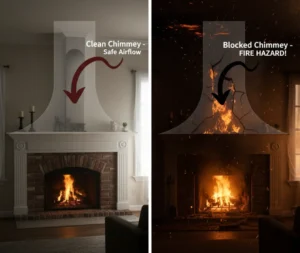If you enjoy a cozy fireplace during a Houston “cold snap,” you’re probably wondering about the maintenance schedule. It’s a question we hear all the time at Texas Chimney LLC: “How often should I clean my chimney?”
The simple, professional answer is that your chimney should be inspected annually and cleaned as needed.
This isn’t just a suggestion; it’s the standard set by the National Fire Protection Association (NFPA 211). While inspection is a non-negotiable yearly requirement, the need for a deep cleaning is based entirely on how often you use your fireplace and what you burn.
This detailed guide will break down the crucial difference between a chimney inspection and a sweep, explain the critical factors that dictate your cleaning frequency, and outline why an annual appointment with Texas Chimney LLC is the single most important step for fire safety in your Houston home.
The Golden Rule: Annual Inspection, Cleaning as Needed
Most homeowners mistakenly equate a chimney sweep (cleaning) with an inspection. They are two different services, and both are vital to safety.
1. The Annual Chimney Inspection (Level 1)
You should schedule a professional chimney inspection every single year, regardless of how often you use your fireplace. Why?
NFPA Compliance: The NFPA, the authority on fire safety codes, mandates an annual inspection.
Preventative Safety: An inspection catches small problems before they become expensive, dangerous repairs.
Identifying Hazards: The technician checks for blockages (like bird nests or debris), signs of water intrusion, chimney component deterioration, and, most importantly, the buildup of creosote.
A Level 1 inspection, which is included with every chimney sweeping service from Texas Chimney LLC, is a thorough visual check of the readily accessible portions of the chimney structure, flue, and appliance. If you need a more in-depth assessment, perhaps after a home sale or an event, we offer more detailed Chimney Inspection services.
2. The Chimney Cleaning (Sweep)
A chimney cleaning, or “sweep,” is performed to remove built-up creosote and soot. You need a sweep when the creosote layer reaches 1/8 of an inch or more. This is a highly flammable, tar-like residue, and at this thickness, your chimney is a significant fire hazard.
For a family in Houston, the average residential usage usually dictates a sweep every one to two years. However, this can change dramatically based on your burning habits.
4 Key Factors Determining Your Chimney Cleaning Frequency
Your personal chimney usage will always override a generic guideline. Here are the four biggest factors that determine when your chimney needs a cleaning:
Factor 1: The Amount of Usage
This is the most straightforward factor. More fires mean more creosote.
- High Usage: If you use your fireplace daily or even weekly throughout the fall and winter, you will likely need a chimney sweep every year.
- Moderate Usage: If you only light a fire a few times a month, you might be able to go every two years between cleanings, provided the inspection is still done annually.
- Low Usage: If you’ve only used the fireplace a handful of times in the last year or two, you may only need the annual inspection.
Factor 2: What You Are Burning (Fuel Type)
The type of wood you burn has a massive impact on creosote production.
- Seasoned Hardwood (Good): Well-seasoned, dry wood (hardwoods like oak or pecan) burns hotter and cleaner, producing far less creosote. This allows you to go longer between cleanings.
- Green or Softwood (Bad): Wood that hasn’t been properly dried (green wood) or softwoods (like pine or fir) produce a lot of smoke and moisture, which leads to a rapid, sticky buildup of creosote. If you burn this type of wood, you should plan on sweeping annually or even more often.
Factor 3: Burning Habits and Fire Efficiency
How you build and manage your fires affects the chimney’s condition.
- Smoldering Fires: Low-temperature, smoldering fires produce the worst type of creosote: a sticky, tar-like residue that is extremely hard to remove and highly flammable (Stage 3 creosote).
- Hot, Efficient Fires: Fires that burn hot and fast with plenty of air draft reduce smoke and moisture, leading to cleaner burning.
- Wood Stove vs. Open Fireplace: Wood stoves are often more efficient but can also produce high levels of creosote if the air intake is restricted to make the fire last longer.
Factor 4: Chimney Condition and Draft
The physical condition of your chimney plays a role.
- Chimney Leaks: If your chimney is damaged and allows water to enter, this moisture combines with soot to create an acidic sludge that accelerates deterioration. If your chimney has experienced a leak, you may also need Chimney Repair services to fix the issue.
- Poor Draft: A chimney that doesn’t draft well meaning smoke doesn’t exit efficiently will cool faster, causing creosote to condense on the flue walls more rapidly.
Beyond the Sweep: Maintenance That Keeps Your Chimney Clean Longer
While sweeping removes the problem, proper maintenance can slow creosote buildup and improve overall efficiency.
1. Install a Chimney Cap
A high-quality chimney cap is essential. It prevents rain, debris, and, critically, animals (birds, squirrels, raccoons) from entering your flue. An animal nest is a major fire hazard and can block the escape of toxic carbon monoxide. Protecting your flue from the elements and pests helps maintain a clean passage between sweeps.
2. Check the Damper and Flue Liner
The damper should seal completely when the fireplace is not in use to keep air (and pests) out. The flue liner is the barrier that protects the brick and your home’s structure from the intense heat of the fire. Our inspection services always check the integrity of the flue. If it’s damaged, you need a professional repair immediately.
3. Consider Dryer Vent Cleaning
While not directly related to your chimney, many people overlook another serious home fire hazard: the dryer vent. Lint buildup in your dryer vent can cause a catastrophic fire. When our technicians are at your Houston home for a chimney service, it’s an excellent time to bundle and ask about our expert Dryer Vent Cleaning services to ensure both of your major venting systems are safe.
What Happens During a Professional Chimney Sweep?
When you call Texas Chimney LLC, here is what you can expect during the cleaning process:
- Preparation: We lay drop cloths and use powerful, specialized HEPA filter vacuums to ensure a completely mess-free experience inside your home.
- Level 1 Inspection: A thorough visual examination of the firebox, damper, and smoke chamber to check for any visible defects or obstructions.
- Video Scanning (If Needed): If the technician spots something concerning, we use a chimney camera to inspect the entire length of the flue lining.
- The Sweep: The technician uses specialized brushes and rods, working from either the top (roof) or the bottom (fireplace), to dislodge all creosote and soot.
- Clean-Up: All debris is safely removed via the vacuum system, and the work area is left immaculate.
- Safety Report: You receive a detailed report on your chimney’s condition, safety recommendations, and a professional assessment of when your next cleaning will likely be required.
Your Safety Is Our Priority
There’s no need to play a guessing game with fire safety. If you use your fireplace at all, an annual inspection is necessary to comply with safety codes and maintain peace of mind. A cleaning (sweep) is necessary once the creosote reaches the danger threshold of 1/8 inch.
Don’t wait until you see warning signs like heavy smoke, a bad smell, or a chimney fire to call. If you’re unsure about the condition of your flue, the safest move is to schedule a professional inspection.
As a certified local business, Texas Chimney LLC is here to provide honest assessments, transparent pricing, and the highest standard of service in the Greater Houston area.
Contact us today to schedule your annual inspection or visit our website to get an honest assessment of your cleaning needs.





